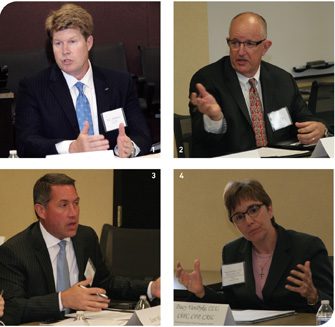
1. Challenges posed by investor attitudes about the relative security of bonds will become more serious for advisers as rates rise, said KC Mathews. | 2. Bob Rippy concurred, saying that the direction of rates in recent months posed a “ticking time bomb” if it continued. | 3. Scott Fletcher cited the potential for properly structured bond porfolios to capture earnings even in a climate of rising rates. | 4. For investors, diversification in bond holdings it’s just as crucial as it is when it comes to owning stocks, said Tracy VanDyke.
Dana Abraham of UMB Private Wealth Management suggested that current fears might be different from those that investors exhibited a year ago, but KC Mathews saw a common thread. “It’s uncertainty,” he said. “There’s no certainty out there because Congress doesn’t do what it’s supposed to do; they don’t act.”
Brian Kaufman of Prairie Capital Management said the negotiations that resolved much of the fiscal-cliff furor at year-end had eased some of the tension and calmed investor waters but Mathews saw that outcome as limited to one investor class. “That’s true with some of the wealthier folks,” he said, “but in general, no.”
Rippy cited the prolonged drag on interest rates, which only now are stirring after a long flirtation with historical lows thanks to the Fed’s monetary policy. Not only have bondholders had to deal with reduced yields, he said, but those who bought more to help balance those reduced returns could have put themselves in a difficult position. “You’ve got a little ticking time bomb” in the effect of higher interest rates, he said, “and we’ve seen a little bit of that happen in some investors who have a much longer maturity portfolio than they probably should be having with the current risk situations.”
As rates tick back up, he said, there will be “a shock to the system to a lot of people unaware of the risk.” Anticipating that potential outcome, he said, Baird had been working with clients to alert them to the dangers.
Too many investors, especially those burned by the 2008–09 market downturn, stayed away from equities even as the stock market tacked on nearly 9,000 points from its recessionary lows. Now their options are limited. “You’ve got investors who don’t really know what to do with new money. They feel very paralyzed,” said Scott Fletcher. The recent adjustment in interest rates, where 10-year Treasuries have added a full point with a matter of months, wiped out two years’ worth of gains for some bondholders.
KC Mathews sees the bond quandary as a serious issue for wealth managers. “I think a lot of investors have unknowingly taken on an incredible amount of risk as they sought out alternatives in the fixed-income space,” he said. But after a bull run of three decades in the bond markets, “when that party ends, the question is, will they be handed the broom?” he asked. “That’s a big issue for us as advisers to be thinking about and how can we advise clients to manage their risk in fixed income.”
Success, though, is still possible in that environment, Fletcher noted, with structural changes, changes in duration, and a keener understanding that some bond issuers are both providing decent rates of return and have the stability to provide peace of mind, if not a guarantee. In other words, not every local government in the municipal bond market, he said, is a Detroit or an Illinois.
The duration of the bull run had predictable results with many investors, said Lynn Mayabb of BKD Wealth Advisors. “Historically, they think there’s no risk, or very little risk. You have to have that conversation with them about what is the real risk in their portfolio and are they willing to assume it.”
That’s important, said Tracy VanDyke, who also noted that not all bonds are created equal. Too many people, she said, “feel good, they’ve got 50 percent of their money in intermediate-term bonds and don’t realize that they’ve got to diversify those bonds and make sure they’re not overexposed to any one sector, any one type of bond or interest rate.”
Fletcher, as well, noted that there’s more than one way to play bonds. “You maybe give up a little on the front end in terms of income,” he said, but with a properly diverse bond portfolio “you can participate in a rising rate environment and replace income over time.”